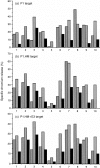Autoreactive cytotoxic T cells in mice are induced by immunization with a conserved mitochondrial enzyme in Freund's complete adjuvant
- PMID: 10447741
- PMCID: PMC2326842
- DOI: 10.1046/j.1365-2567.1999.00762.x
Autoreactive cytotoxic T cells in mice are induced by immunization with a conserved mitochondrial enzyme in Freund's complete adjuvant
Abstract
Standard methods to generate autoimmune reactions in mice, by immunization with antigens emulsified with adjuvants, stimulate strong helper (CD4) T-cell and antibody responses but are not reported to induce cytolytic CD8 T cells. The aim of this study was to assess whether specific autoreactive CD8 T cells could be readily generated after immunization with a 'weak' autoantigen in adjuvant. Mice were immunized intraperitoneally three times with the E3 subunit of the mitochondrial 2-oxoacid dehydrogenase enzyme complexes (dihydrolipoamide dehydrogenase) emulsified with Freund's complete adjuvant. Splenic and lymph node lymphocytes were harvested after 14 days for in vitro functional studies. T lymphocytes were tested for proliferative responses and cytotoxicity against antigen-loaded isogeneic target cells. An autoreactive cytolytic T lymphocyte (CTL) response was detectable only after the in vitro restimulation of lymphocytes with E3 antigen-loaded syngeneic splenocytes. These CTL were identified as H-2-restricted CD8+ T cells. A proliferative response to E3 was demonstrable against antigen-pulsed syngeneic splenocytes. Immunized mice also generated strong antibody responses to E3. Liver histology showed portal infiltrates interpreted as a response of the liver to a non-specific immunological stimulus. It is concluded that autoreactive cytolytic T cells can be generated experimentally upon appropriate stimulation of the immune system, and can be identified in vitro upon release from the controlling mechanisms that are likely to regulate them in vivo.
Figures







Similar articles
-
Autoreactive MHC-restricted cytotoxic cells in BALB/c mice after novel immunisation with a conserved mammalian autoantigen.Cell Immunol. 1993 Apr 15;148(1):166-76. doi: 10.1006/cimm.1993.1099. Cell Immunol. 1993. PMID: 8495485
-
Ovalbumin injected with complete Freund's adjuvant stimulates cytolytic responses.Eur J Immunol. 1995 Feb;25(2):549-53. doi: 10.1002/eji.1830250237. Eur J Immunol. 1995. PMID: 7875219
-
Comparison of CTL reactivity in the spleen and draining lymph nodes after immunization with peptides pulsed on dendritic cells or mixed with Freund's incomplete adjuvant.Immunol Lett. 2003 Nov 15;90(1):13-8. doi: 10.1016/s0165-2478(03)00158-5. Immunol Lett. 2003. PMID: 14611902
-
T cell-depleted splenocytes from mice pre-immunized with neuroantigen in incomplete Freund's adjuvant involved in protection from experimental autoimmune encephalomyelitis.Immunol Lett. 2014 Jan-Feb;157(1-2):38-44. doi: 10.1016/j.imlet.2013.11.001. Epub 2013 Nov 9. Immunol Lett. 2014. PMID: 24220208
-
Hepatic portal infiltrates in mice immunized with syngeneic lymphoid cells: connotations for models of autoimmune liver disease.J Gastroenterol Hepatol. 1995 Sep-Oct;10(5):491-7. doi: 10.1111/j.1440-1746.1995.tb01337.x. J Gastroenterol Hepatol. 1995. PMID: 8963023
Cited by
-
Enhancing efficacy of HIV gag DNA vaccine by local delivery of GM-CSF in murine and macaque models.J Interferon Cytokine Res. 2006 Jun;26(6):380-9. doi: 10.1089/jir.2006.26.380. J Interferon Cytokine Res. 2006. PMID: 16734558 Free PMC article.
References
-
- Bernard CCA, Mandel TE, MacKay IR. Experimental models of human autoimmune disease: Overview and prototypes. In: Rose NR, Mackay IR, editors. The Autoimmune Diseases II. Orlando: Academic Press; 1992. p. 47.
-
- Nagata M, Santamaria P, Kawamura T, Utsugi T, Yoon JW. Evidence for the role of CD8+ cytotoxic T cells in the destruction of pancreatic b cells in NOD mice. J Immunol. 1994;152:2042. - PubMed
-
- Yoneda R, Yokono K, Nagata M, et al. CD8 cytotoxic T-cell clone rapidly transfers autoimmune diabetes in very young NOD and MHC class I-compatible mice. Diabetologia. 1997;40:1044. - PubMed
-
- Ohno S. ‘Self’ to cytotoxic T cells has to be 1000 or less high affinity nonapeptides per MHC antigen. Immunogenetics. 1992;36:22. - PubMed
MeSH terms
Substances
LinkOut - more resources
Full Text Sources
Molecular Biology Databases
Research Materials

